
In our previous installment, we established that content marketing has made some drastic changes over the last few decades, and along with it, the way we construct content has evolved as well. Incidentally, this is where the concept of the so-called pillar content comes in.
Here’s the question: How exactly are we supposed to do that? What is pillar content, in the first place? And what does this mean for the future of content? Keep reading, because we have all the answers here.
Building the foundation for the future of content marketing
As the name suggests, your pillar content is the framework of the content strategy for your website; a solid structure holding your content together. Think of it as the cornerstone that provides support to your house. It needs to be strong; otherwise, your house will end up collapsing. The pillar content page is an all-in-one source which all the other content are anchored on to. It’s basically a souped-up landing page.
This strategy has been around since the early 2000s, but its system and structure have proven to be more effective in today’s market compared to a decade ago.
Generally, pillar content must have the following characteristics:
- It has a high authority rating.
- It has abundant organic traffic.
- It is hosted by a URL where the core topic is included.
- Its content should be available for all website visitors without the need to fill out a form
Seriously, how?
First, you will need to understand your content and blog purpose, and identify your buyer personas. As with any great marketing strategy, the better you understand your audience, their pain points, and how you can provide value using your content, the more effective your pillars will be.
Online marketing tools like HubSpot provide easy, step-by-step processes for establishing pillar content using a Content Strategy tool. Of course, having those types of tools does not save you from coming up with the core topic of your company’s website. Thus, you must first embark on the meticulous task of keyword research to create a sturdy pillar page.
The core topic should be a broad term between two to four words. It must be industry-specific, educational, and must support your company’s products and services. Having an educational core is ideal as it would relate to your website visitors currently in the awareness stage of their buyer’s journey. Perform several Google search on the core term to see what other people are writing in relation to your chosen core topic.
Next, identify about 4 - 10 core topics relevant to your business. Around each of those core topics, create a cluster of longer-tail subtopics. In developing each subtopic into pieces of web content, link them back to the core topic to avoid misalignment. Your company’s website may already contain relevant information in its archive, you can use those as supporting articles or additional content.
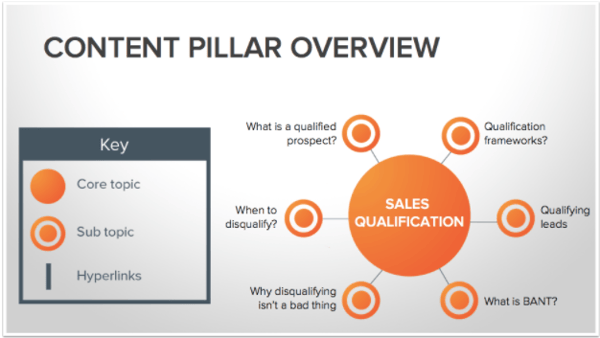
Although the pillar page doesn’t use forms to get into your content, you can still generate contacts by converting the page into a PDF and offering that to potential leads as people are more likely to consume long-form content as a PDF.
HubSpot’s Content Strategy Tool
For HubSpot users, the platform’s Content Strategy tool can help launch pillar pages that look perfect across devices with just a few clicks.
Here is a step-by-step guide to creating a pillar page through HubSpot:
- Navigate to Content > Strategy.
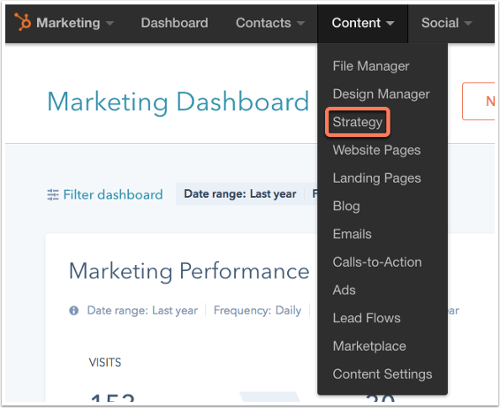
- Click the topic cluster name you wish to add a pillar page to.

- Once in the topic cluster editor, click the core topic bubble. In the left sidebar, click Create new pillar page
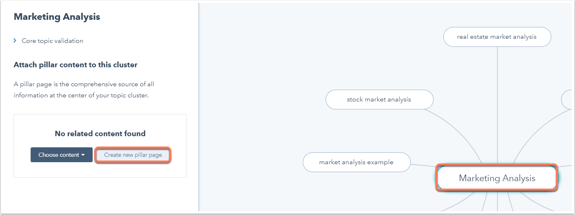
- In the dialog box that appears, type in your pillar page's name and click Create.
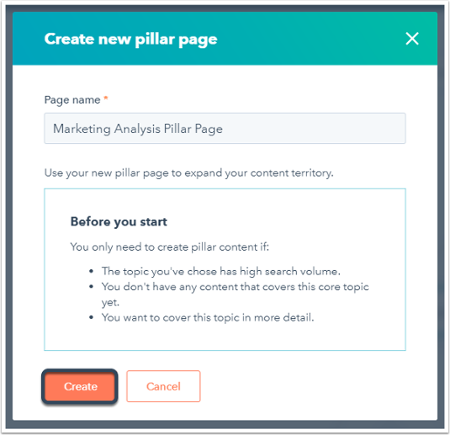
- Once you hit Create, your pillar page will appear as a draft landing page in the left-hand sidebar. Click Edit landing page to edit your new pillar page.
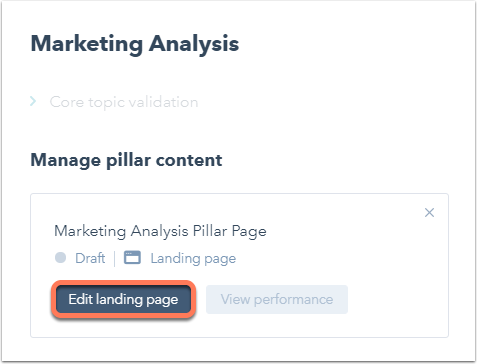
- Proceed to create your pillar page as you would any other landing page. If you decide to save your edits and finish up later, you can retrieve the page right from this sidebar in your topic cluster editor or under Content > Landing Pages in your Draft section.
- Once you publish your pillar page, it will still appear in the left-hand sidebar in the topic cluster as well as under Content > Landing Page in your Published section.
Is putting that much effort worth it?
It is absolutely important to point out the impact of having a sound content marketing strategy for your website. In fact, companies that implement these strategies see 6x higher conversion rates than those who don’t. In the context of modern digital marketing approaches, nothing is as potent as a content marketing strategy than having pillar content. It’s compounding, meaning organic search increases traffic over time. Even though only 1 out of 10 blog posts perform in this manner, it still generates 38% of overall traffic.
As mentioned earlier, these pillars provide structure to your overall content plan. It helps you focus on the things that your business and your buyer personas are all about. Pillars allow you to develop meaningful content that’s relatable and effective at raising awareness among its readers. Having a sustainable content creation process will prevent misalignment (and burnout) in your content strategy. So, is it worth it? Yes, without a doubt!
Okay, so what’s next?
Now that you have created a pillar content page, it is imperative that you regularly promote it. You have worked hard to develop this page, so you better make sure that it goes out in public.
In this ever-changing digital world, it pays to have a strong foundation and the right set of knowledge and tools to stay ahead of the pack. After all, the future of content is a fast-paced and rapidly evolving landscape. Those who resist change, crumble; those who embrace it, thrive. Choose to be the latter — build a strong content marketing strategy with equally strong pillar content.
Need help in managing and creating a content that can support your inbound marketing strategy? Get on a free, no-obligation discovery call with our team to get started.
















Comments